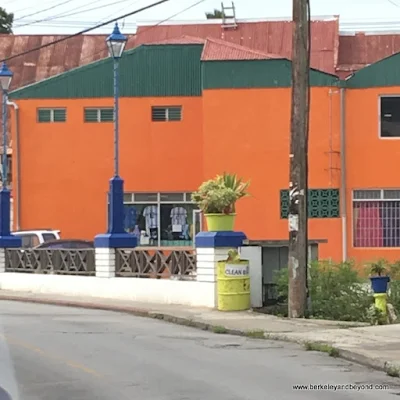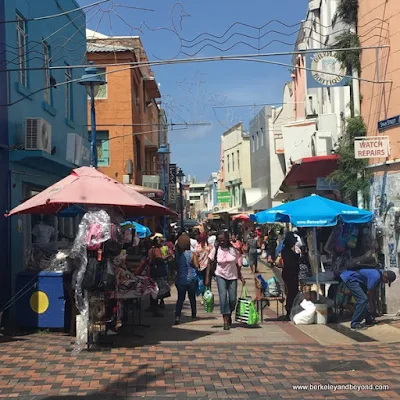A BRIEF HISTORY OF THE ISLAND
Located 1,600 miles southeast of Miami (about 62 miles east of its nearest neighbors, the Windward Islands), Barbados is the easternmost Caribbean island. Measuring just 17 miles long and 14 miles wide (166 square miles total), it is a tiny island.In the 15th century, the indigenous Kalinago people were conquered by the Spanish. In 1627 the British took over. They colonized the island and brought African slaves to work the land and build up the island’s sugar cane industry. The sugar revolution made Barbados wealthy and also the heaviest populated place in the world. It was a center of agriculture and trade, and at one time became the second-largest shipping port after Boston. Barbados was strategically the best place in the Caribbean for a garrison, and St. Anne's Garrison defended England’s power in the West Indies.
It is interesting to know that the term “Barbados’d” is used to note that a person was kidnapped and forced into slave labor in Barbados. But many slaves managed to escape and turned to piracy.
Slavery was abolished in Barbados in the 1830s, but the island remained under British rule until 1966, when black islanders were given the rights to own property.
The earliest settlements were in Holetown, Speigeltown, and Bridgetown
 |
| colorful building on main artery through Barbados |
CONNECTION WITH SOUTH CAROLINA
There are strong ties between Barbados and South Carolina. Indeed, Barbados is the only country to found a U.S. colony (South Carolina), and 7 of South Carolina’s first 21 governors were Barbadian. And that is just a bit of that story. Learn more about the connection at the Barbados and Carolinas Legacy Foundation.CURRENT ISLAND
 |
| character guide in Bridgetown, Barbados |
The African influence dominates the island’s cultural expression in art, music, dance, and food. But Barbados is also affectionately known as “Little England” because nearly half of its tourists come from the U.K. Thus British cricket and high tea are popular activities. And everyone speaks English.
 |
| art in Champers restaurant in Barbados |
Barbados is located below the hurricane belt and therefore not often impacted by hurricanes, which usually stay about 200 miles north of the island. The last one that hit the island was in 1955. However, it affected by tropical storms, including Kirk in 2018.
 |
| vegetable stand in Bridgetown, Barbados |
A haven for nature lovers, Barbados offers a big and mountainous interior. Considering it is such a small island, there's a broad range of things to do here. The capital city of Bridgetown holds impressive colonial buildings, and both it and the historic garrison are designated UNESCO World Heritage sites. Island sights include sprawling sugar plantations, historic museums, beautiful botanical gardens, and deep caverns. The island's tropical beauty includes white and pink coral-sand beaches, and warm ocean waters welcome swimming, snorkeling, surfing, and diving.
 |
| pink hibiscus in Barbados |
And many unusual animals are found here. One of the few Caribbean islands with monkeys, Barbados is home to the green monkey--which arrived here from Senegal and the Gambia in West Africa around 350 years ago. It has flourished through 75 generations, and there are now are around 7,000 on the island. The unusual black belly sheep has no wool and looks like a goat. Giant snails are sometimes spotted slithering along the sidewalks, and whistling frogs can make quite a clatter.
Traditional Bajan cuisine is a melange of African, Indian, Irish, Creole, and British influences. The island has plenty of fancy fine-dining restaurants with gourmet menus and is the only island in the Caribbean to have its own Zagat guide. Popular everyday fare includes exotic flying-fish sandwiches, macaroni pie, and a vast assortment of pepper sauces. And this island is where the grapefruit originated. Barbados claims to be the birthplace of rum. Derived from sugar-cane, rum is amazingly made with just molasses, yeast, and water. This tasty drink is served throughout the island. Corner rum shops are perhaps the most popular places to imbibe, and the island has somewhere between 1,500 and 18,000--depending on who you’re talking to. Similar to English pubs, these shops are uniquely Barbadian and are hubs of Bajan social life. Backs beer--a light crisp pilsner style--is the local favorite.
images ©2019 Carole Terwilliger Meyers







Wow, Carole, I learned several things I didn't know about Barbados. I had no idea there was a connection to South Carolina; how interesting! And I didn't know it's where grapefruit originated! Thanks for the informative post.
ReplyDeleteI had no idea Barbados had so many monkeys! Are they considered a nuisance as they are on Nevis? I'd love to return to Barbados and spend some time exploring the rum scene especially those rum shops.
ReplyDeleteI wasn't used to a long post from you. But there are just too many interesting facts about Barbados! Too bad it's not included in a lot of Caribbean cruises.
ReplyDeleteWow, didn't know about the South Carolina connection or the green monkeys. But yes indeed, some of the best rums in the world. Very nice article.
ReplyDeleteWe haven't really explored very many of the islands, so your article really opened up a new experience for us. Barbados looks like an amazing place to explore, and we will definitely add it to our travel list. Thanks for sharing. Travel safely!
ReplyDeleteI spent a day in Barbados some years ago. It was beautiful and I really want to go back!
ReplyDelete